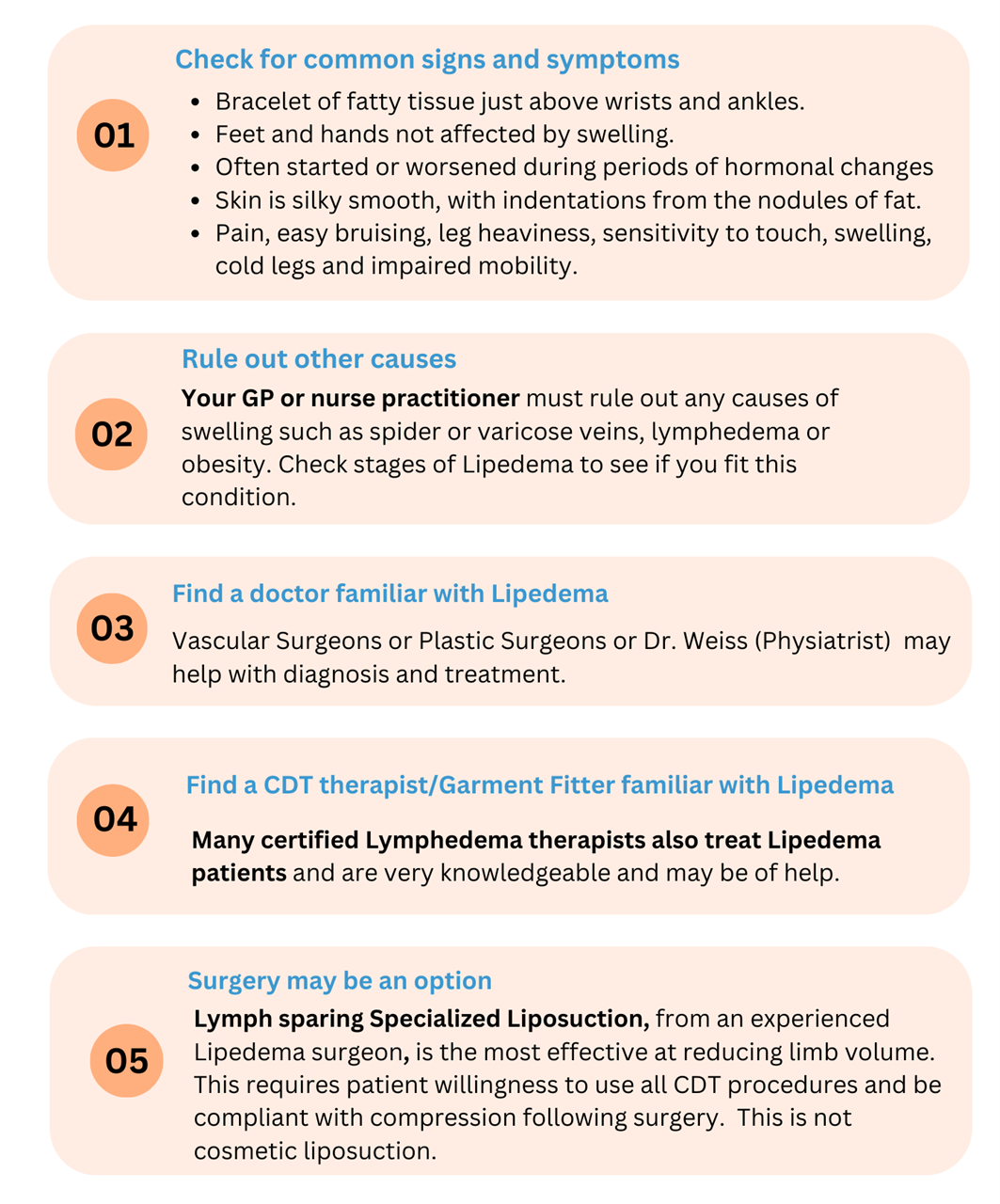 | Login |
WHAT IS LIPEDEMA
Lipedema: Adipose Tissue Disorder
Lipedema is a chronic condition caused by an abnormal proliferation and deposition of adipose/fatty tissue. It is not obesity. This condition is present in approximately 11% of the female population. (Foldi et al, 2005)
Lipedema was first recognized by The Mayo Clinic in 1940.
What are the underlying triggers?
Lipedema may be inherited and often arises in relationship to hormonal changes including; puberty, pregnancy or peri-menopause.
Characteristics:
-Bilateral, symmetrical fatty deposits in the legs and arms of women. It is rare in males.
- Typically affects legs (upper and/or lower), buttocks, hips, arms (upper only or upper and lower)
- Usually the trunk, feet and hands are unaffected, unless there is a lymphedema component.
- Often, a “bracelet” of fatty tissue can be palpated, just above the wrists and ankles.
- Skin is typically silky smooth, with indentations from the nodules of fat (similar to a cushion with a button sewn into it).
-Not uncommon to have spider veins, skin infections, large fat gains & reduction in mobility.
-Due to poor recognition of this condition, it is not uncommon for depression & anxiety to be present.
Lymph fluid accumulates around the proliferating fatty tissue, which compromises the integrity of the lymphatic system causing the body tissue and limbs to appear engorged and swollen. Blood vessels, capillaries, nerves & lymph vessels in the regions of the fatty tissue deposits are contorted or squeezed by the presence of the enlarged fat cells.
The blood capillaries being fragile will become leaky, putting more fluid into the tissues which often respond to light pressure with bruising.
Eventually, when BMI exceeds 30-40, the enlarged fatty deposits, put pressure on or restrict the lymph vessels which are unable to remove the excess fluid. This then adds lymphatic dysfunction to the fatty tissue disorder. This is known as a Lipo-lymphedema.
How can you manage lipedema?
The following “conservative measures” will aid in pain reduction & hypersensitivity:
1. Compression garments - knee high, thigh high, leggings, arm compression sleeves (while highly recommended, are often not tolerated in the beginning)
2. Self management through education in Complete Decongestive Therapy (CDT) this includes the following :-
3. Dietary measures to reduce inflammation & weight loss: - Most women with lipedema will have been told (especially at onset) to diet or restrict caloric intake. Lipedema fat itself does not respond to dieting. However a nutritionist can provide useful information on reducing weight through general dietary principles*.
5. Exercising is highly recommended for optimal health and pain management. Aquatic exercise is especially effective, when vertical in the water the hydrostatic pressure creates compression.
6. Pain needs to be managed:- squeezed nerves in the affected region are much more sensitive to touch.
7. Social support &/or counselling is necessary to deal with psychological impact of the disease.
8. Dry Brushing (if tolerated)
9..Manual Lymphatic Drainage massage ( MLD ) might offer comfort although will not have any impact on reducing volume of fat cells. This type of massage is effective in moving lymph fluid which may also be present when the BMI is over 40
10.Therapists do not prescribe, but supplements such as Dr. Karen Herbst’s Supplement Protocol, may be helpful.
11.Surgical measures: Lymph sparing Liposuction, is the most effective at reducing limb volume. This requires patient willingness to use all CDT procedures & be compliant with compression following surgery.
In BC, patients need prior approval from the Medical Services Plan (MSP) for surgery to be covered.
There an only a few surgeons qualified to perform this surgery on patients with lipedema
The VGH Lymphedema program started performing de-bulking liposuction in 2021.
However due to the number of lymphedema patients on the wait list they are not taking lipedema patients at this time.
For further information refer to: CLF website https://canadalymph.ca
Lymphedema Guru blog Lipedema.
* Nutritionist Jean LaMantia www.jeanLaMantia.com
BC Lipedema and Lymphedema Facebook Support Group
and Lipedema BC & Yukon Facebook group
STAGES OF LIPEDEMA
Lipedema develops in stages.The level of pain, tenderness, swelling and fat accumulation may increase over time. The image below provides an overview of the four stages of Lipedema, showing the location of fat build up and resulting body shape at each stage. Depending on the person, different parts of the body can be affected in different ways at each stage.
This staging criteria, although often used, does not take into consideration pain, size, impact on joints, loss of mobility, or other impacts to quality of life. Other criteria are sometimes used.
.jpg)

DIAGNOSIS/TREATMENT STEPS FOR LIPEDEMA
SYMPTOMS OF LIPEDEMA
%20(5).png)
DOCTORS FOR LIPEDEMA DIAGNOSIS & TREATMENT
At this time, unfortunately, we do not have a list of vascular surgeons and plastic surgeons that diagnose and treat Lipedema in B.C.
.png)
